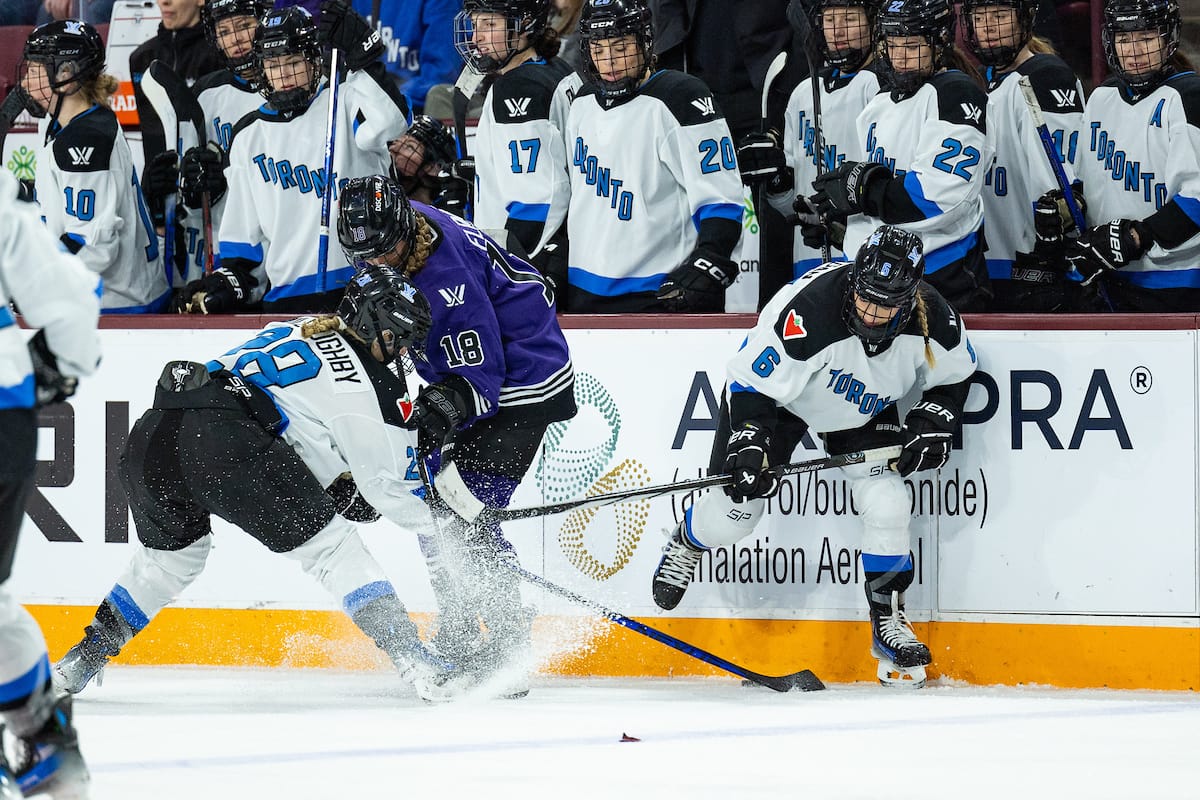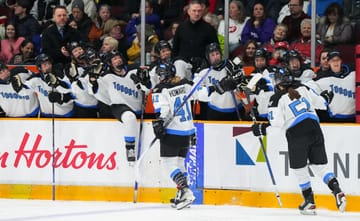We have known since the beginning of the season that the top four teams would make the playoffs, and there were some assumptions that came along with that – namely that it would follow a traditional 1v4 and 2v3 format for first-round matchups, and that the bottom-ranked team would get first pick in the 2024 draft. (This got to the point that PWHL Toronto's poor start was described by some analysts as "tanking for Sarah Fillier" – Princeton and Team Canada's offensive dynamo who is a current favorite for first overall pick in 2024.)
However, the PWHL has decided to do things a little differently. On February 28, the League announced that they would be adopting an unconventional format for playoff matchups and determining draft order. The League will adopt the Gold Plan for the draft order – and they'll be letting the regular season champs pick their semifinal opponent.
Playoff Format
First, the more straightforward aspect of this news: the top-ranked team will actually get to pick their first-round matchup, deciding between the third-ranked and fourth-ranked team. PWHL SVP of Hockey Operations Jayna Hefford stated that the top-ranked team's staff will get to make that determination. The decision could be based on a variety of factors: a more favorable travel schedule, a better matchup, or statistical trends.
Each semifinal matchup, and the championship series, will consist of a best-of-five series. The #1 and #2 ranked teams will have home ice advantage for the first, second, and fifth games of the series, meaning there will be significant travel involved throughout the postseason schedule. In all playoff games, if the score is tied after regulation, teams will play 5-on-5 full overtime periods until someone scores a goal.
The playoffs will commence the week of May 6, 2024. After the conclusion of the regular season on May 5, the top-ranked team will be given a 24-hour window during which to select their first-round opponent.
The Gold Plan
The "Gold Plan" was first proposed by statistician Adam Gold at the 2012 MIT Sloan Sports Analytics Conference in Boston. Under the Gold Plan, the team that accumulates the most wins after being mathematically eliminated from playoff contention will earn the first draft pick in the following year's draft. The logic is that the team that is mathematically eliminated first has the most opportunities (games) to accumulate points, and this provides an incentive for that team to actually win those games.
Points accumulated under the PWHL's points system (3 points for a regulation win, 2 points for OT/SO win, 1 point for an OT/SO loss, and 0 points for a regulation loss) after mathematical elimination from playoff contention will be considered "draft order points" towards that first overall pick.
At the time, the plan was controversial and it still has detractors. The claim is that it sets expectations too high on teams that simply can't be expected to win games, and may breed animosity among players for being asked to win games for a team that may not re-sign them. Which may be partially true in a large, established men's league like the NHL or the NBA – but that would seem to be a problem with those leagues, rather than the PWHL.
Even in the NHL, there are a lot of pluses for introducing the system, and the arguments against it, to me, seem more like enforcing a rigid standard of predictability than actually incentivizing teams to perform well and do their jobs throughout the course of an entire season. Outside of professional sports, we accept at face value that winning isn't everything and that the journey to your result is as important if not more important than the result itself – and the Gold Plan is a step towards codifying that for a sports team, by giving both front offices and players something to focus on when the playoffs are no longer in the picture.
And the PWHL is the perfect lab setup to try something like the Gold Plan out in professional hockey.
With just six teams that have such a high talent level, the margins to qualify for the postseason are going to be razor thin and it may come down to just a handful of games to solidify the rankings in the bottom half of the league. The spread between the #1 ranked team (Montreal) and the bottom-ranked team (New York) is just eight points. The spread between #3 (Toronto) and #6 is just five points – less than two regulation wins in the PWHL's system. Any team that can string a couple of regulation wins together has a chance of leapfrogging in the standings overnight.
On top of that, any team in the PWHL can beat any other team. We've seen it happen again and again. The motivation to "play spoiler" is often cited when a team that is likely (or definitely) going to miss the playoffs comes up against a team that is favored in the postseason, and now playing spoiler has real, tangible benefits to your organization.
If you've talked to any women's hockey player before, you know they want to win, but also that they care a lot about details and want to put the best version of themselves on the ice regardless of the circumstances. Players already want to play their best every night, and this gives GMs and coaches a structure to point to that says their hard work matters regardless of the standings or what point it is in the season.
I think it's fun, especially since the portion of the schedule after any team's mathematical elimination could come down to just a few games. The last week of April and those first few days of May are going to be intense. I genuinely expect the #4 playoff spot to be up for grabs until very late – and that when the draft order point system kicks in, there won't be very many games left to play. It won't be a long slog at the bottom, but an opportunity to play some exciting, meaningful hockey in April and May.
The 2024 Draft
The draft will follow a traditional format, as opposed to the inaugural draft's "snake" format. The first pick in each round will go to the winner of draft order points in the regular season. The second pick will go to the runner-up in draft order points. The rest of the order will be determined by how each team finished in the regular season standings, as follows:
- Team that obtained the most draft order points
- Team that obtained the second-most draft order points
- Team that finished 4th overall in the regular season
- Team that finished 3rd overall in the regular season
- Team that finished 2nd overall in the regular season
- Team that finished 1st overall in the regular season
At some point after the conclusion of the 2024 PWHL postseason, there will be a window during which teams can conduct trades that include picks in the 2024 draft.
The draft will consist of 7 rounds and 42 players will be picked. Teams can hold those players' rights for up to 2 years if the player is not signed to a standard player agreement for the 2022-25 season; after two years, if the player has not been signed, they may declare for the draft again. A player may only declare for up to two drafts. Undrafted players who were declared eligible will become free agents.
The draft declaration process opened today (March 1, 2024) and will remain open until May 8. All players who intend to join the PWHL must enter the draft, which will take place in June. This means that European players, recent college grads, and others looking to join the fray will be available, as in the inaugural draft.
Only 55 players in the PWHL are currently signed to multi-year deals, so there could be significant roster turnover in Year Two, with many players slated to become free agents at the conclusion of the season. There will be a lot of competition for roster spots among newly drafted players and players who already have a season of PWHL hockey under their belts.
The free agency period begins on June 21, 2024.
Rough Timeline/Key Dates
- March 1, 2024: Draft declaration window opens
- May 5, 2024: Final day of PWHL regular season
- Week of May 6, 2024: Playoffs begin
- May 8, 2024: Draft declaration window closes
- June (before June 21): 2024 PWHL Entry Draft
- June 21, 2024: Free agency begins
(Photo: Kelly Hagenson/PWHL)







